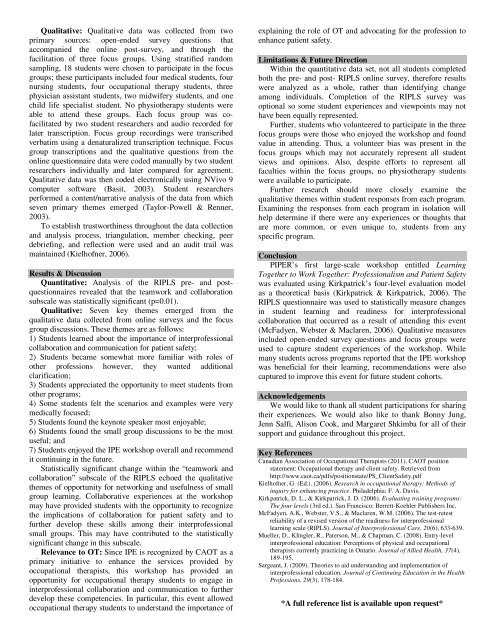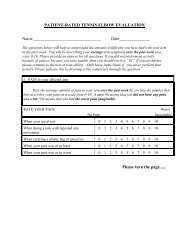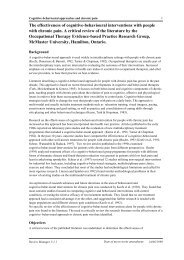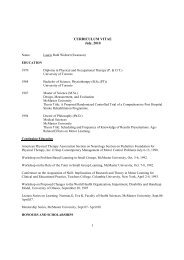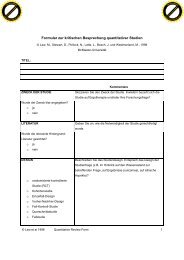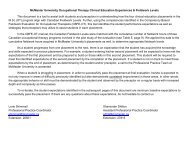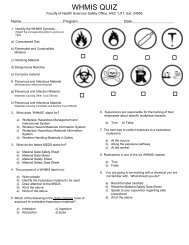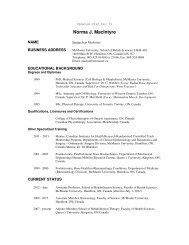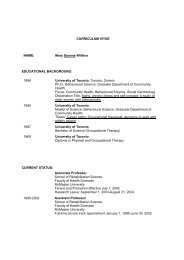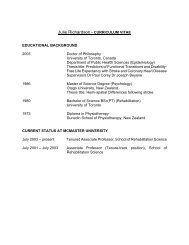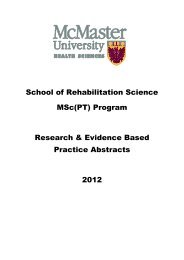Evidence Based Practice Symposium - McMaster University
Evidence Based Practice Symposium - McMaster University
Evidence Based Practice Symposium - McMaster University
You also want an ePaper? Increase the reach of your titles
YUMPU automatically turns print PDFs into web optimized ePapers that Google loves.
Qualitative: Qualitative data was collected from two<br />
primary sources: open-ended survey questions that<br />
accompanied the online post-survey, and through the<br />
facilitation of three focus groups. Using stratified random<br />
sampling, 18 students were chosen to participate in the focus<br />
groups; these participants included four medical students, four<br />
nursing students, four occupational therapy students, three<br />
physician assistant students, two midwifery students, and one<br />
child life specialist student. No physiotherapy students were<br />
able to attend these groups. Each focus group was cofacilitated<br />
by two student researchers and audio recorded for<br />
later transcription. Focus group recordings were transcribed<br />
verbatim using a denaturalized transcription technique. Focus<br />
group transcriptions and the qualitative questions from the<br />
online questionnaire data were coded manually by two student<br />
researchers individually and later compared for agreement.<br />
Qualitative data was then coded electronically using NVivo 9<br />
computer software (Basit, 2003). Student researchers<br />
performed a content/narrative analysis of the data from which<br />
seven primary themes emerged (Taylor-Powell & Renner,<br />
2003).<br />
To establish trustworthiness throughout the data collection<br />
and analysis process, triangulation, member checking, peer<br />
debriefing, and reflection were used and an audit trail was<br />
maintained (Kielhofner, 2006).<br />
Results & Discussion<br />
Quantitative: Analysis of the RIPLS pre- and post-<br />
questionnaires revealed that the teamwork and collaboration<br />
subscale was statistically significant (p=0.01).<br />
Qualitative: Seven key themes emerged from the<br />
qualitative data collected from online surveys and the focus<br />
group discussions. These themes are as follows:<br />
1) Students learned about the importance of interprofessional<br />
collaboration and communication for patient safety;<br />
2) Students became somewhat more familiar with roles of<br />
other professions however, they wanted additional<br />
clarification;<br />
3) Students appreciated the opportunity to meet students from<br />
other programs;<br />
4) Some students felt the scenarios and examples were very<br />
medically focused;<br />
5) Students found the keynote speaker most enjoyable;<br />
6) Students found the small group discussions to be the most<br />
useful; and<br />
7) Students enjoyed the IPE workshop overall and recommend<br />
it continuing in the future.<br />
Statistically significant change within the “teamwork and<br />
collaboration” subscale of the RIPLS echoed the qualitative<br />
themes of opportunity for networking and usefulness of small<br />
group learning. Collaborative experiences at the workshop<br />
may have provided students with the opportunity to recognize<br />
the implications of collaboration for patient safety and to<br />
further develop these skills among their interprofessional<br />
small groups. This may have contributed to the statistically<br />
significant change in this subscale.<br />
Relevance to OT: Since IPE is recognized by CAOT as a<br />
primary initiative to enhance the services provided by<br />
occupational therapists, this workshop has provided an<br />
opportunity for occupational therapy students to engage in<br />
interprofessional collaboration and communication to further<br />
develop these competencies. In particular, this event allowed<br />
occupational therapy students to understand the importance of<br />
explaining the role of OT and advocating for the profession to<br />
enhance patient safety.<br />
Limitations & Future Direction<br />
Within the quantitative data set, not all students completed<br />
both the pre- and post- RIPLS online survey, therefore results<br />
were analyzed as a whole, rather than identifying change<br />
among individuals. Completion of the RIPLS survey was<br />
optional so some student experiences and viewpoints may not<br />
have been equally represented.<br />
Further, students who volunteered to participate in the three<br />
focus groups were those who enjoyed the workshop and found<br />
value in attending. Thus, a volunteer bias was present in the<br />
focus groups which may not accurately represent all student<br />
views and opinions. Also, despite efforts to represent all<br />
faculties within the focus groups, no physiotherapy students<br />
were available to participate.<br />
Further research should more closely examine the<br />
qualitative themes within student responses from each program.<br />
Examining the responses from each program in isolation will<br />
help determine if there were any experiences or thoughts that<br />
are more common, or even unique to, students from any<br />
specific program.<br />
Conclusion<br />
PIPER’s first large-scale workshop entitled Learning<br />
Together to Work Together: Professionalism and Patient Safety<br />
was evaluated using Kirkpatrick’s four-level evaluation model<br />
as a theoretical basis (Kirkpatrick & Kirkpatrick, 2006). The<br />
RIPLS questionnaire was used to statistically measure changes<br />
in student learning and readiness for interprofessional<br />
collaboration that occurred as a result of attending this event<br />
(McFadyen, Webster & Maclaren, 2006). Qualitative measures<br />
included open-ended survey questions and focus groups were<br />
used to capture student experiences of the workshop. While<br />
many students across programs reported that the IPE workshop<br />
was beneficial for their learning, recommendations were also<br />
captured to improve this event for future student cohorts.<br />
Acknowledgements<br />
We would like to thank all student participations for sharing<br />
their experiences. We would also like to thank Bonny Jung,<br />
Jenn Salfi, Alison Cook, and Margaret Shkimba for all of their<br />
support and guidance throughout this project.<br />
Key References<br />
Canadian Association of Occupational Therapists (2011). CAOT position<br />
statement: Occupational therapy and client safety. Retrieved from<br />
http://www.caot.ca/pdfs/positionstate/PS_ClientSafety.pdf<br />
Kielhofner, G. (Ed.). (2006). Research in occupational therapy: Methods of<br />
inquiry for enhancing practice. Philadelphia: F. A. Davis.<br />
Kirkpatrick, D. L., & Kirkpatrick, J. D. (2006). Evaluating training programs:<br />
The four levels (3rd ed.). San Francisco: Berrett-Koehler Publishers Inc.<br />
McFadyen, A.K., Webster, V.S., & Maclaren, W.M. (2006). The test-retest<br />
reliability of a revised version of the readiness for interprofessional<br />
learning scale (RIPLS). Journal of Interprofessional Care, 20(6), 633-639.<br />
Mueller, D., Klingler, R., Paterson, M., & Chapman, C. (2008). Entry-level<br />
interprofessional education: Perceptions of physical and occupational<br />
therapists currently practicing in Ontario. Journal of Allied Health, 37(4),<br />
189-195.<br />
Sargeant, J. (2009). Theories to aid understanding and implementation of<br />
interprofessional education. Journal of Continuing Education in the Health<br />
Professions, 29(3), 178-184.<br />
*A full reference list is available upon request*


